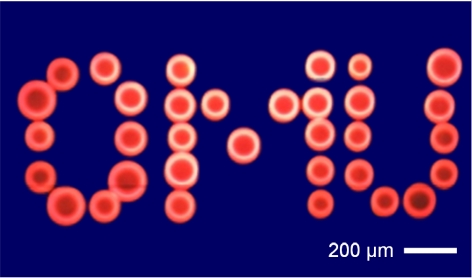| Oct 02, 2023 |
Next-generation printing: precise and direct, using optical vortices
(Nanowerk News) Will printed photographs ever match the precision of a mirror's reflection? Even though the answer may still be no for a while, Osaka Metropolitan University scientists have made significant strides in precision printing with their innovative optical vortex laser-based technique that allows for the precise placement of minuscule droplets with micrometer-scale accuracy.
|
 |
| A set of 33 droplets fabricated to create “OMU” using the optical vortex laser-induced printing technique: The novel technique precisely deposited the droplets with no satellite droplets produced. (Image: Ken-ichi Yuyama, Osaka Metropolitan University)
|
|
Inkjet technology is a well-known printing technique that emits microdroplets from a nozzle directly onto a surface. However, when the ink droplets are viscous, with high density, the nozzle often gets clogged, a concern that has prompted the search for more advanced technologies.
|
|
A research team led by Dr. Ken-ichi Yuyama, a lecturer at the Graduate School of Science of Osaka Metropolitan University, has succeeded in printing uniformly sized droplets, with a diameter of approximately 100 µm, using a liquid film of fluorescent ink – which is approximately 100 times more viscous than water. This was achieved by irradiating the film with an optical vortex, resulting in prints of exceptional positional accuracy at the micrometer scale.
|
|
“Using a special laser beam known as an optical vortex, we have achieved stable printing of high-viscosity liquids,” explained Dr. Yuyama. “This printing technique allows for the fabrication of microdroplet laser arrays and the micropatterning of conductive nanoinks, as well as bioinks for cell scaffolds, leading to the establishment of next-generation printed photonic or electronic devices.”
|
|
The research results were published in ACS Photonics ("Fabrication of an array of hemispherical micro-lasers using optical vortex laser-induced forward transfer").
|

